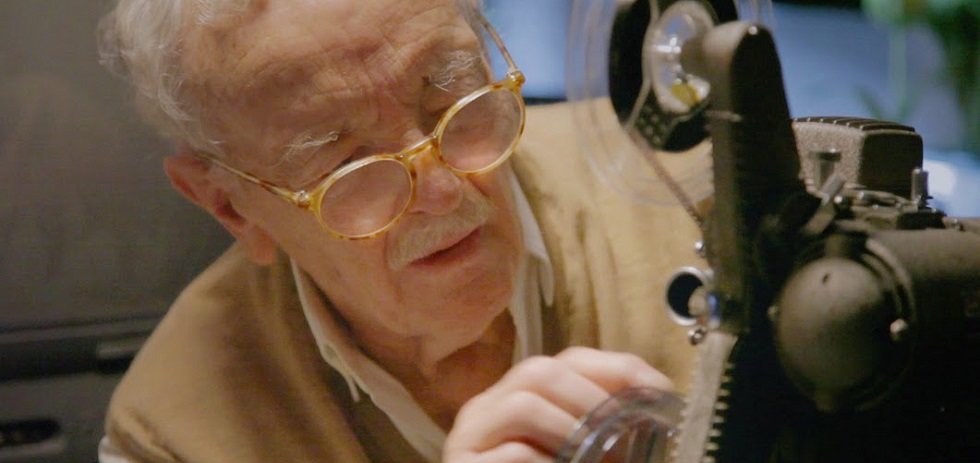Tracking the career of famous pornography director Peter De Rome in the lead up to the addition of his body of work into the BFI National Archive, Peter De Rome: Grandfather of Gay Porn is an intriguing look at the life of a staunchly independent filmmaker operating on the fringes of film society – although his output is not as visually extreme as such a statement may suggest.1 A British ex-pat who assisted in the early days of the American Civil Rights movement, worked at the Manhattan branch of Tiffany’s during the production of Breakfast at Tiffany’s, and (eventually) ended up working for decades in Paramount’s publicity department, all while shooting very personal and eventually infamous shorts in his spare time, Peter De Rome was a soft-spoken, highly opinionated man with a personality that is about as far removed from that of the traditional stereotypical pornography director imaginable.
The feature-length documentary debut of filmmaker Ethan Reid,2 Grandfather of Gay Porn follows Peter De Rome as he travels around the world, visiting the cities in which he shot his infamous material, and tracing his past through his filmography. This is intercut with interviews that establish his importance as a filmmaker; he was one of the first to demonstrate an accurate portrayal of homosexual life on camera in a period where most on-screen gay characters would have a mental breakdown or kill themselves by the end of a feature,3and was also one of the only people to present non-white homosexual individuals on celluloid in the late ’60s and early ’70s, giving power and autonomy to these figures on-screen. Much of this work was also created during periods where it was illegal to engage in homosexual activity and possession or manufacture of films portraying it would land you in jail.
Perhaps what is most interesting about the actual documentary, however, is that the life and output of Peter De Rome is filtered through and recounted by the man himself, rather than a faceless, omniscient voice (as is the case with many of these sorts of documentaries). It gives the film a very personal feel, echoing the very personal nature of his own work; De Rome was nearly always making films for himself that depicted his fantasies and exploits, rather than acting as a gun for hire for pornography production companies or other individuals (although he did occasionally take on larger projects). It’s a pretty fascinating counter-narrative to the typical portrayal of the pornography industry in other documentaries, that tend to focus on exploitation and remove personal autonomy from those operating within it – this is mostly as a result of the fact that De Rome was much more like an independent filmmaker or an artist than a pornographer, but it’s a refreshing take on the medium nonetheless.
The film also offers a nice narrative on the other side of Porno Chic; most discussions of the era focus purely on the hetero side of “art porn” output in the ’70s, however a case is made for the work of men like Wakefield Poole and Peter De Rome, two individuals that eventually gained (some) mainstream recognition for experimental, plot-driven, non-hetero pornographic features during this time. This is perhaps the film’s most interesting revelation as it is a counter-history that is oft-glossed over, as most discussions of the Porno Chic era that seem to focus solely on films like Deep Throat, The Devil In Miss Jones, and Debbie Does Dallas. It’s an alternative history that I wish was explored in greater detail, although it’s probably an interesting enough topic to warrant its own documentary. Besides, it seems unfair to lump Peter De Rome in with the other pornographic directors of his time, as he comes across as much more of an independent art film director than he does as a pornographer in the narrative purveyed by Grandfather of Gay Porn.4
In later moments the film does start to become a bit directionless, hitting on a number of topics but departing from the structure dictated by a historical timeline. The final third of the film explores issues like the AIDS epidemic (the catalyst that stopped Peter De Rome from making future films), the fate of old shooting locations (and an embedded look at gentrification), and the state of the modern gay porn industry (spoiler alert: it looks like the gendered power relations that muddy the waters in the hetero pornographic industry don’t really exist here), all in minor detail. In saying this, these diversions are all at least somewhat interesting in their own right and don’t detract from the film’s overall quality, rather they prevent it from becoming even better than it already was, stalling its pacing. Overall, the film is a solid watch, an interesting exploration of the man and his output and a decent counter-point to documentaries that either hinge solely on painting the pornographic industry as an area of exploitation (that often remove autonomy from its workers and become exploitative in and of themselves), or border on functioning as pornography themselves – I’m looking at you, The Real Blue Nuns – even though the film has its fair share of explicit material. If there’s ever been a case made for pornography’s function as a work of art, this is it.

